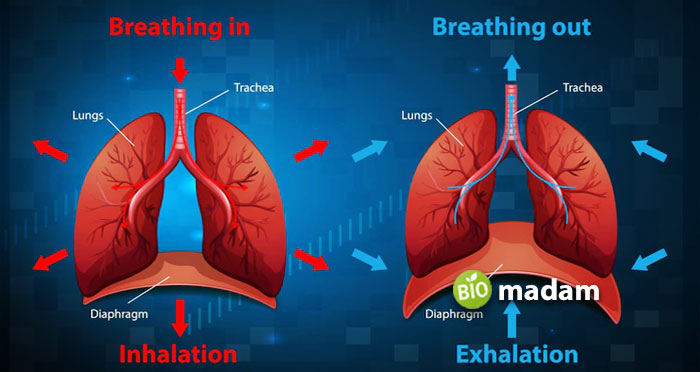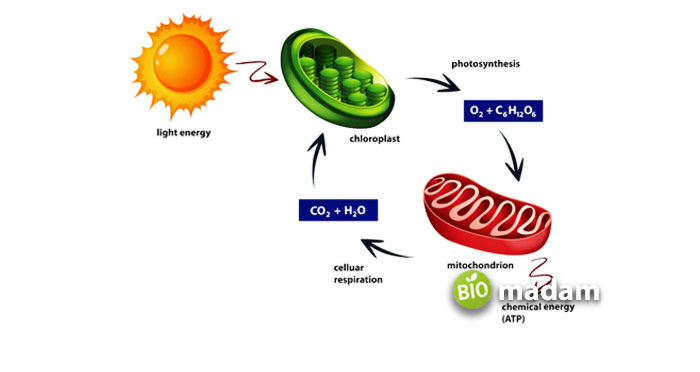Our entire respiratory system is a complex network of organs and tissues that helps a human breathe. Respiration is the process of the exchange of gasses among body cells, the organism, and the environment. It occurs in all prokaryotic and eukaryotic organisms. Respiration is primarily of three types; external respiration, internal respiration, and cellular respiration.
External respiration involves inhalation and exhalation, which we call breathing. You can even practice various breathing exercises to help improve your health condition. The other kind of respiration is internal respiration which refers to the exchange of gases between the tissues and body fluids.
Cellular respiration, contrary to fermentation, occurs at the cellular level. It refers to the process of converting energy from biological compounds and molecules to produce ATP. It may or may not use oxygen in the process of producing energy. Cellular respiration is divided into aerobic and anaerobic respiration, depending on the presence or absence of oxygen.
Here’s a breakdown of the different types of respiration for your understanding.
External Respiration
External respiration is simply the process of breathing in animals. It differs in plants, with the name cellular respiration, that utilizes mitochondria for functioning. Animals use the process of respiration to intake oxygen through numerous means. Usually, animals have specialized organs like gills (in fish) and trachea (in spiders), or a respiratory system through which respiration takes place. Some organisms do not have specialized organs to intake oxygen through diffusion by external tissue surfaces. One such example is nematodes, in which gases and nutrient exchange takes place through a diffusion type.
Humans have a proper respiratory system consisting of multiple organs. It helps in blood intake and its purification to supply oxygen to blood cells. The air enters the human body through the nose or the mouth. It passes through the trachea and reaches both sides of the lungs. Besides inhalation, exhalation also takes place simultaneously. It results in changes in the breathing rate and helps maintain a breathing mechanism for proper body functioning.

Internal Respiration
Once the air reaches your internal body surface, its distribution takes place through internal respiration. Internal respiration is the second type of respiration found in living organisms. It is the transport of gases between body tissues, blood, and plasma. When the oxygen enters the lungs, it diffuses across the thin epithelium into nearby capillaries with less oxygen.
Carbon dioxide also sweeps through the tissues in the opposite direction to be removed from the body. The oxygen-rich blood in the vessels is then supplied to body tissues and organs through capillaries. The transport of oxygen and carbon dioxide in and out of the body takes place through the body’s respiratory function.
Cellular Respiration
Cellular respiration refers to the internal respiration within the cells. Cellular respiration uses the glucose obtained by metabolism and uses it to produce energy. This energy is released by the breakdown of food. The food is metabolized within the body to disintegrate it into nutrients used to carry out other body processes. The nutrients are then absorbed into the bloodstream and circulated throughout the body to supply cells with energy.
It occurs through various channels and steps in which oxygen and glucose are converted into water, carbon dioxide, and ATPs. ATPs produced through cellular respiration power normal cellular functions like movement, synthesis, muscle contraction, etc. Carbon dioxide and water produced during ATP synthesis diffuse into the interstitial fluid around the cells.

Types of Cellular Respirations
While respiration seems straightforward, energy production takes place through different processes. It is divided into aerobic and anaerobic respiration. Aerobic respiration consists of Krebs’ cycle, Glycolysis, and the electron transport chain.
Aerobic Respiration
Aerobic respiration refers to the use of oxygen to produce energy. It generates 38 ATP molecules in prokaryotes and 36 ATP molecules in eukaryotes by oxidizing a single glucose molecule. Aerobic respiration is the most common cellular respiration in animals and comprises three steps.
Glycolysis
Glycolysis takes place through the oxidation of glucose into pyruvate. The process occurs in the cytoplasm, where the pyruvate undergoes further oxidation after entering Krebs’ cycle in the inner matrix of the mitochondria. Two ATP and two NADH molecules are released through the process.
Kreb’s Cycle
Kreb’s cycle produces two more ATP molecules besides NADH, FADH2, and Carbon dioxide. It also produces electrons that move through the cristae and generate an electric gradient. This charge gradient enables the electron transport chain pump hydrogen protons into the interstitial spaces.
Electron Transport Chain
The electron transport chain comprises electron carrier proteins in the mitochondrial membrane that helps in the transport of electrons. It produces 34 ATP molecules in total. The electron transport chain obtains energy from FADH2 and NADH produced in Krebs’ cycle. These hydrogen protons are then used by ATP synthase to send back proteins to the mitochondrial matrix. It facilitates the phosphorylation of ADP to ATP.
Anaerobic Respiration
Anaerobic is the second type of respiration. However, it does not use oxygen like aerobic respiration. Most extremophiles like archaebacteria and eubacteria survive in environments without oxygen. But how do they produce energy without using oxygen?
Archaebacteria involve the utilization of iron, nitrate, sulfur, or carbon dioxide instead of oxygen. It also forms an electrochemical gradient through the electron transport system producing ATP molecules. Yet, as no oxygen is involved, the final electron recipient is also another molecule. Some organisms are facultative anaerobes, while others are obligate anaerobes. Facultative anaerobes perform aerobic respiration in the presence of oxygen. On the other hand, obligate anaerobes do not survive in the presence of oxygen.
Why is Respiration Important?
While we mentioned the types of respiration, why do organisms need to respire? Respiration is responsible for all bodily processes. It helps transport oxygen to various parts of the body through blood. The energy produced through respiration facilitates biochemical processes. Animals replenish their oxygen through this process while plants obtain their carbon dioxide requirement. That is why photosynthesis and respiration both are essential for plants. Each glucose molecule produces 673 Kcal energy in the form of 38 ATP molecules.
The Bottom Line
Respiration is a process vital to all living organisms. Animals respire through the intake of oxygen, and aerobic respiration takes place. Conversely, bacteria and archaebacteria breathe anaerobically through sulfur or nitrogen. Facultative anaerobes perform aerobic respiration, whereas obligate anaerobes die in the presence of oxygen. Each molecule of glucose produces 38 ATPs used in various biological processes.

Anna has completed her degree in Pharmacy from the University of Hawaii. She is serving as a research assistant in a pharmaceutical company. She had a great interest in writing blogs, traveling to different parts of the US, and trying delicious recipes in her spare time.

